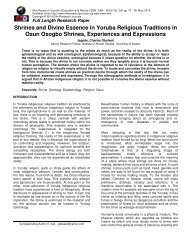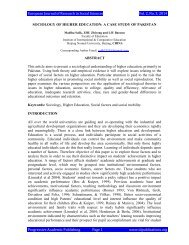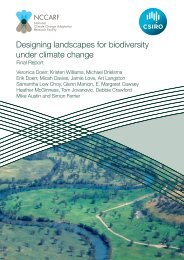Williams-Climate-change-refugia-for-terrestrial-biodiversity_0
Williams-Climate-change-refugia-for-terrestrial-biodiversity_0
Williams-Climate-change-refugia-for-terrestrial-biodiversity_0
You also want an ePaper? Increase the reach of your titles
YUMPU automatically turns print PDFs into web optimized ePapers that Google loves.
more prone to shift their ranges to track favourable climatic conditions rather than to<br />
remain in place and evolve new <strong>for</strong>ms (Parmesan 2006).<br />
The climate variables used in this study were: (i) annual mean temperature; (ii)<br />
temperature seasonality; (iii) maximum temperature of the warmest period; (iv) annual<br />
precipitation; (v) precipitation of the driest period; vi) precipitation of the wettest period;<br />
and (vii) precipitation seasonality. Presence-only modelling methods can be subject to<br />
sampling bias (Yackulic et al. 2013); we account <strong>for</strong> this potential bias by using a<br />
target-group background, which consisted of the locations of the occurrence records <strong>for</strong><br />
the species within that class, as recommended by Phillips et al. (2009). Using the<br />
target group as our background points, it is assumed that any sampling bias in our<br />
occurrence records <strong>for</strong> a single species can also be observed in our background<br />
points; in effect cancelling out the impact of any spatial sampling bias in the modelling<br />
exercise (Phillips and Dudik 2008, Elith and Leathwick 2009, Phillips et al. 2009).<br />
Species distribution models were projected onto future scenarios consisting of the<br />
worst-case scenario RCP8.5 and 18 GCMs <strong>for</strong> 2085. This RCP was used <strong>for</strong> the same<br />
reason it was used <strong>for</strong> examination of future climate. Namely, the current trajectory of<br />
radiative <strong>for</strong>cing and emissions are most closely aligned with this RCP, and by using<br />
the worst-case scenario we have covered the spectrum of outcomes, as the difference<br />
between the RCPs is the severity of <strong>change</strong>, rather than the direction of <strong>change</strong>.<br />
Across the 18 GCMs, the 10 th , 50 th and 90 th percentiles were calculated to give the<br />
median projection and a measure of across-model variance (a measure of uncertainty<br />
in our projections). Due to the large number of species used in this analysis, we<br />
focussed on the shifting climate space of potential distributions by assuming that all<br />
species had unlimited dispersal. This assumption is clearly unrealistic, but<br />
interpretation of our results (section 3.4) is not dependent on the assumption being<br />
true.<br />
The default Maxent distribution output is a continuous prediction of environmental<br />
suitability <strong>for</strong> the species. The output species distribution models <strong>for</strong> current climate<br />
were vetted by comparing the predicted distribution model to the published distributions<br />
(generally equivalent to the Extent of Occurrence based on a minimum convex<br />
polygon) of the species: again, taken from relevant field guides (Menkhorst and Knight<br />
2001, Churchill 2008, Tyler and Knight 2009, Wilson and Swan 2010, Vanderduys<br />
2012), online databases (http://www.arod.com.au/arod/) and from expert opinion. A<br />
binary distribution output was created by applying an appropriate threshold obtained<br />
from the Maxent results output file. Two Maxent-generated thresholds were trialled:<br />
‘equate entropy of threshold and original distributions logistic threshold’ and ‘Maximum<br />
training sensitivity plus specificity logistic threshold’ <strong>for</strong> each species. The one best<br />
representing the known distribution of the species was used (APPENDIX 3. Species<br />
distribution modelling data and model results). The same threshold was used <strong>for</strong> the<br />
species current and future distribution projections. Applying this threshold generates a<br />
map of where we realistically expect the species to be under a given climate.<br />
Model per<strong>for</strong>mance was evaluated by the area under the receiver operating<br />
characteristic curve (AUC). AUC measures each model’s consistency and predictive<br />
accuracy (Ling et al. 2003). An AUC score of 1 is a perfect model fit of the data; 0.5 is<br />
no better than random (Elith et al. 2006, Phillips et al. 2006). AUC values ≥ 0.7 indicate<br />
‘useful’ models, whereas values ≥ 0.9 indicate models with ‘high’ per<strong>for</strong>mance (Swets<br />
1988). Models <strong>for</strong> each species were screened <strong>for</strong> low AUC (






